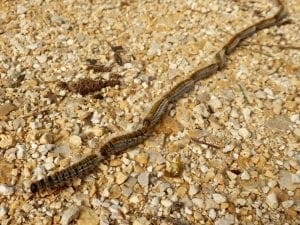Processionary Caterpillars
Dangerous Caterpillars
If you’ve noticed an influx of these hairy Processionary Caterpillars around your area you are not alone. Late summer and early autumn are when we usually see them. A group of the Caterpillars can form in a nest of up to 600 and when they have stripped the tree of leaves they form in single file processionary to find another tree – this is where you can see them in groups traveling and they can travel up to 150 meters!
The problem with these Processionary Caterpillars is that they can be very dangerous to Humans and our pets.
What are processionary caterpillars
The processionary caterpillars starts off as a moth, they lay their eggs in the trees and you can usually see their silken bags. Inside these bag shelters (that look like candy floss) they can have up to 300 caterpillars.
You may see these itchy grubs form a long chain from nose to tail in a processionary shape like form. You will notice it’s ‘barbed like’ hairs that it is covered with. It’s these hairs that can cause irritations to us and be harmful to our pets.
How dangerous are processionary caterpillars
Unfortunately, it’s their hairs that cause the problems. These hairs are designed to be brittle and can barb the skin in contact. They can also float through the air. It is when you come into contact with these many hairs is where the problem can happen.
Caterpillar Allergy
When Humans come into contact with their hairs we can develop from mild to serious reactions, some can break out in hives, welts, itchy eyes and these can last for weeks. With the penetration of the hairs if they go into your eyes it can affect or at worse cause loss of vision.
Reactions to Animals
With dogs/cats the hairs may come into contact with their eyes and cause irritation or it may be on their paws and if they lick their paws or if they are a type of dog to bite the caterpillar it can get on their mouth/tongue and it may cause itching, swelling and possibly vomiting. If your pet does come into contact check for small white spots on the mouth and tongue and excess drooling and take them immediately to the Vet.
How to treat processionary caterpillars
Check around your yard especially on your trees, pay particular attention around the base of the trees and look for the bag shelters (silken nests). Be careful when mowing or whipper snipping as hitting one of those bag shelters you can have thousands of hairs going everywhere. Watch out when walking your pet for any of these processionary caterpillars and stay away. Look for the nests at the base of trees (especially wattles) when going on picnics etc.
If you do find one in your yard, don’t touch it, you can kill them with warm soapy water. If you would like further information contact us on 1300 725 758 and we can help you make your place pest free today.




